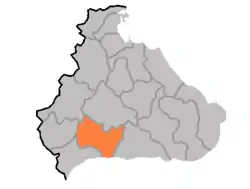Pyonggang County
P'yŏnggang County is a kun, or county, in Kangwŏn province, North Korea. It borders Sep'o to the north, Ch'ŏrwŏn to the south, Ich'ŏn to the west, and Kimhwa to the east.
P'yŏnggang County
평강군 | |
|---|---|
| Korean transcription(s) | |
| • Chosŏn'gŭl | 평강군 |
| • Hancha | 平康郡 |
| • McCune-Reischauer | P'yŏnggang-gun |
| • Revised Romanization | Pyeonggang-gun |
 Map of Kangwon showing the location of Pyonggang | |
| Country | North Korea |
| Province | Kangwŏn |
| Administrative divisions | 1 ŭp, 30 ri |
| Area | |
| • Total | 708 km2 (273 sq mi) |
| Population (1990 est.) | |
| • Total | 100,800 |
Physical features
A portion of the county is occupied by the Ryongam wetlands, which also cross into Ch'ŏrwŏn. Most of the county's terrain is mountainous, although there a few small expanses of level ground. The Kwangju and Majŏllyŏng mountains pass through P'yŏnggang. The region is prone to heavy rains.
History
The P'yŏnggang area was known as Puyang hyŏn during the Koguryŏ period, and as Kangp'yŏng (강평) under Silla. In the Koryŏ Dynasty, it was included in Tongju (동주); in the Chosŏn dynasty, it took its modern name.
Climate
| Climate data for Pyonggang (1981–2010) | |||||||||||||
|---|---|---|---|---|---|---|---|---|---|---|---|---|---|
| Month | Jan | Feb | Mar | Apr | May | Jun | Jul | Aug | Sep | Oct | Nov | Dec | Year |
| Average high °C (°F) | −2.0 (28.4) |
1.4 (34.5) |
7.3 (45.1) |
15.6 (60.1) |
20.9 (69.6) |
24.6 (76.3) |
26.1 (79.0) |
27.2 (81.0) |
23.3 (73.9) |
17.6 (63.7) |
8.5 (47.3) |
0.9 (33.6) |
14.3 (57.7) |
| Daily mean °C (°F) | −7.7 (18.1) |
−4.1 (24.6) |
1.8 (35.2) |
8.9 (48.0) |
14.9 (58.8) |
19.4 (66.9) |
22.2 (72.0) |
22.7 (72.9) |
17.6 (63.7) |
10.9 (51.6) |
3.2 (37.8) |
−4.1 (24.6) |
8.8 (47.8) |
| Average low °C (°F) | −13.8 (7.2) |
−9.7 (14.5) |
−3.3 (26.1) |
2.3 (36.1) |
9.1 (48.4) |
14.6 (58.3) |
18.9 (66.0) |
18.8 (65.8) |
12.4 (54.3) |
4.9 (40.8) |
−2.0 (28.4) |
−9.2 (15.4) |
3.6 (38.5) |
| Average precipitation mm (inches) | 15.5 (0.61) |
22.7 (0.89) |
35.5 (1.40) |
52.5 (2.07) |
88.7 (3.49) |
124.4 (4.90) |
390.7 (15.38) |
278.7 (10.97) |
132.4 (5.21) |
43.4 (1.71) |
44.5 (1.75) |
22.1 (0.87) |
1,251.1 (49.26) |
| Average precipitation days (≥ 0.1 mm) | 5.8 | 5.2 | 7.0 | 7.1 | 8.3 | 10.1 | 16.7 | 13.8 | 7.7 | 5.8 | 7.6 | 7.0 | 102.1 |
| Average snowy days | 7.6 | 6.5 | 5.2 | 0.5 | 0.0 | 0.0 | 0.0 | 0.0 | 0.0 | 0.2 | 2.2 | 6.8 | 29.0 |
| Average relative humidity (%) | 74.4 | 71.6 | 70.1 | 65.1 | 70.0 | 76.9 | 85.9 | 83.9 | 79.0 | 73.9 | 74.8 | 75.2 | 75.1 |
| Source: Korea Meteorological Administration[1] | |||||||||||||
Administrative divisions
On August 15, 1945, P'yŏnggang county included 1 ŭp(P'yŏnggang), 6 myŏn(Sŏ, Nam, Hyŏnnae, Mokchŏn, Sep'o, Yujin). Presently, it is divided into 1 ŭp and 30 ri (villages):
|
|
Economy
The county is well-suited to agriculture, and rice farming is especially developed. In addition, the mines of P'yŏnggang extract gold, tungsten, nepheline, zircon, alunite, and diatomaceous earth.
References
- "30 years report of Meteorological Observations in North Korea" (in Korean). Korea Meteorological Administration. pp. 232–281. Archived from the original on 21 December 2020. Retrieved 21 December 2020.
External links
- (in Korean) In Korean language online encyclopedias:
